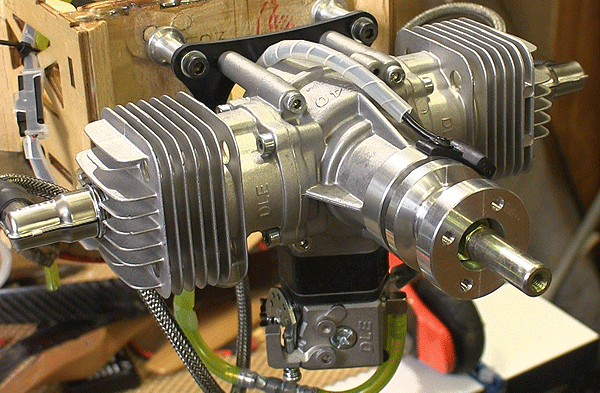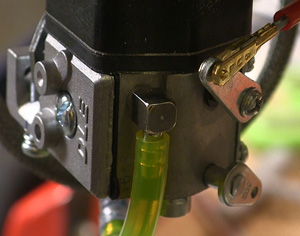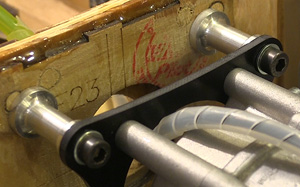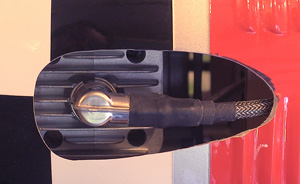



This as my first twin cylinder engine
and I fell in love with the sound and
power not to mention the DLE reliability.
Text, photos and video by Tom Hintz
Posted – 8-11-2014
I always liked the look and sound of opposing, two cylinder airplane engines. When I saw the DLE 40-size twin and determined that its 180mm width head to head not including the straight spark plugs would fit (or close) in my Pilot 26% YAK 54 cowl my electric YAK experiment ended rather abruptly. The 50cc Rimfire motor and Castle speed control have been carefully stored and may show up again in a larger plane later.
The DLE-40 Twin Gas Engine (#DLEG0040) 40-cc (2.45 cu-in) displacement comes from a bore of 1.26-in (32 mm) and a 0.98-in (25 mm) stroke. The all up weight for this motor is just 3.3-lb (1.5 kg) which includes the mufflers, ignition module, spark plugs and mounts. The DLE-40 Twin Gas Engine comes with the electronic ignition module, 2 mufflers and spark plugs, standoffs, spiral wire wrap, connector safety clips & manual. Oddly while they supply the standoffs the blind nuts and bolts to mount the motor are left for you to find. They call for 5mm-diameter by 45mm long socket head cap screws but I suspect that length might vary a tad depending how thick your firewall is.
The DLE-40 Twin cranks out 4.8 hp @ 8500 rpm with an RPM range of 1500-8500. The rated static thrust is 20.9 lb (9.5 kg) at 328 feet altitude. Add all that to the 19x8, 19x10, 20x8 & 20x10 range of props this motor will swing and I was confident that my YAK would be quite happy with it.
You do have to add an ignition battery and they suggest 4.8-8.4 Ni-Cd or NiMH, 6.6V LiFe or 2S LiPo pack. And we need to come up with 2 cycle oil for the specified 30:1 mix. I will be as precise as I can when mixing the oil and will use high quality oil. If something were to go wrong it could be hard to claim warranty service if I was cutting corners on the oil/gas mixture.

The carb looks like a WalBro clone
and it worked much like the WalBro.
I removed the electric motor and speed control before I fit and epoxied a 3/8”-thick piece of plywood behind the factory firewall. The DLE-40 Twin manual calls for at least 3/8”-thick so combined with the original 3/16”-thick firewall I felt more comfortable in the motor box ability to withstand the shake of a gas engine. I also painted wood glue over all of the motor box joints. While I was doing that I decided to fuel proof the motor box area with wood glue as well.
The mounting bolt patter for the DLE-40 Twin is different from the 50cc Rimfire so sealed those holes with hardwood dowels epoxied in place. When the epoxy cured I filed everything flat to get ready for drilling the DLE-40 Twin mounting holes. The on line manual has a pattern on the back page for these mounting holes and you can print that page.
The instruction manual that came with my DLE-40 Twin did not have the mount pattern or much of the information contained in the on-line manual. I strongly suggest either printing out the on-line manual from the DLE site or keeping that link handy for reference. Be careful when using the mount hole pattern as it is shown on the page with the long axis vertical as do the accompanying photos in the manual. My DLE-40 Twin came with the mounting plate with the long axis on the horizontal plane which makes more sense and it matches the laser-drawn pattern that is lasered onto the Pilot 26% YAK 54 original firewall. I would still print out the pattern from the on-line manual and match that up to the firewall to be sure.

The included standoffs turned out to be
just right for the Yak.
The first time we started the DLE-40 Twin it took a little flipping. It would not draw fuel on its own at first but I put my thumb over the carb and flipped it (ignition off) and two flips filled the line. With the choke on it still took a bunch of flips to get it to fire but it did and with the choke off it did start, again with several flips.
I ran the DLE-40 Twin on the starting stand for several minutes, varying the throttle as we went. After that first start the DLE-40 Twin has been easy to get going and that continues now with a dozen or so flights on it. I should note that the early flights were done without the cowl. I wanted to insure plenty of airflow during the first flights when the engine is most likely to see “break in heat”.
The first flight did produce a sudden dead stick when the motor simply shut off at about 1/3 throttle. That produced a broken landing gear but I had a spare so we fixed it up right there are the field. During that repair, Dennis, one of our highly experienced gas fliers installed a set of NGK CM-6 plugs in my DLE-40 Twin in place of the DLE plugs and it has run great ever since. It seems that a large segment of the gas engine crowd use this NGK CM-6 plug and I am now a member of that crowd.
After fitting the cowl the DLE-40 Twin richened up a bunch, enough that I worried about it shutting off again in the air. I landed it and once again with the help of Dennis, we worked through several flights, each preceded by tiny carb adjustments. By the end of the evening, with Dennis’s help we had the DLE-40 Twin running somewhat rich but reliably. For the next couple of gallons of fuel I intend to leave it right there to further the break in process.
I think it is important to note that during this tuning process remarkably small changes made to the adjusting screws on the DLE carb produced very noticeable results. During our tuning 1/8-turn on one of the adjusting screws was a lot. Most of the tuning tweaks were just that, a tweak, maybe the width of the screw driver blade. After each tweak another flight was put in to see how performance changed in flight and each time the change was noticeable.
I should note that in the accompanying video there is no footage of the initial starts or flights. I did in fact have the video camera in the car but in the excitement of starting the motor I flat forgot all about it. In addition to the new gas power I was anxious to get the Pilot 26% YAK 54 into the air to see how it flew after losing a solid 7 pounds of overall weight! And this was not a calculation; I weighed the plane, all up before and after the power change. It went from right at 18 pounds with electric power to 11 pounds once the DLE-40 Twin was installed. It was like I had bought a brand new airplane. I am chalking this up to believing what the airplane manufacturer says the flying weight should be.

I did have to cut the cowl to fit but not
as much as I anticipated.
I have been flying the DLE-40 Twin as much as possible and have at least a couple dozen flights on the motor. As of yesterday the motor is getting much smoother and the idle speed continues to drop and stabilize. I have not used a tach on it but the final three flights yesterday showed a much slower landing speed and very short run out after touchdown. We are very close.
The DLE-40 Twin performance in the air is also cleaning up despite still being a bit rich. Throttle transition is getting more positive and I am increasingly confident in the stability of the lower throttle positions. I even started flying inverted with no serious loss of rpm. I did some inverted flat spins and other mild aerobatics and though it lacks a bit of speed yet, the DLE-40 Twin pulls through all of them nicely.
I did make one tiny low speed adjustment yesterday, maybe a screw driver blade width leaner and I could notice the difference. It is still a bit rich and while I would love to bring the DLE-40 Twin up to full song I can wait. At the rate I am flying it and the amount of fuel I am putting through the DLE-40 Twin each flying day, a couple more weeks should have it fully broken in and ready for more aggressive flying. I will sneak up on the final carb settings to avoid going too lean but the DLE-40 Twin is getting to be way more fun to fly and getting a solid 10 minute flights with 1/3 of the 16-ounce tank remaining is nice as well.
The smoothness of the DLE-40 Twin’s opposing cylinders is an important factor as well. People that fly single cylinder gas engines and have held my DLE-40 Twin during starting remark about how smoothly it runs. Besides, a twin cylinder engine looks very cool as well. This is a win-win.
This is my first DLE engine but I can assure you that it will not be my last. My DLE-40 Twin cost $449.00 (7-26-2014) which is itself a bargain. However considering that the DLE-40 Twin comes with the mufflers, ignition system, spark plugs and standoffs that bargain gets closer to a steal in today’s RC marketplace.
While I have not had my DLE-40 Twin long enough to attest to its durability I can say that there are a number of DLE motors happily flying at our field and aside from changing over to the NGK spark plugs there have been no issues with any of them.
If you are looking for a gas motor you really need to look at the DLE line. They offer lots of motors in lots of sizes including twin cylinder versions. If you compare weights, power and cost the DLE line gets more attractive. I really like being able to add this kind of performance for this low a cost so I can preserve part of my RC budget for the next plane – which will also have a DLE engine on it.
See the DLE-40 Twin product page – Click Here
Have a comment on this review? –Email Me